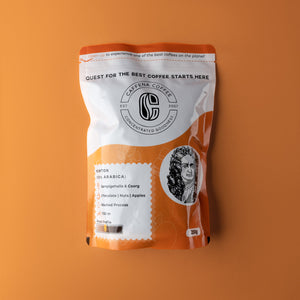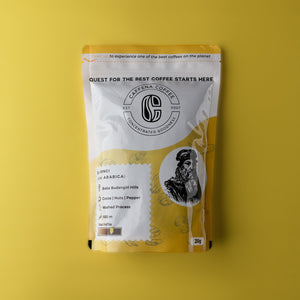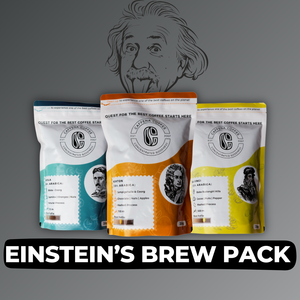The goal of the article: Help people understand roasting and coffee flavours
According to the Specialty Coffee Association’s Flavour Wheel, there are 110 observable flavour profiles in your daily cup of coffee. The question we get asked often is where these flavours originate from
And we like to divide this process into 2 parts for simplicity's sake
- Pre-roasting
- Roasting
Pre Roasting
There are 3 factors that influence the flavour profiles of a coffee in the pre-roasting stage. And these play a crucial role in deciding how roasters select coffees. These factors are
For example, the most famous varietals you will observe in Single Estate Coffees are Cauvery (known for its citrus berry-like flavours) and SL-9 (known for its balanced sweetness and an overall chocolatey/nutty flavour.
So by the rule of thumb growing a Cauvery Arabica with a dark roast or other factors that don’t suit its fruity flavour profile would not make for the best experience.
So an SL-9 from Baba Budangiri or a Cauvery from Araku Valley could be a good combination to look out for.
The washed/wet process involves washing off the fruit and the beans. Which are then dried in the sun or shade. The washed process will give the coffee a clean and unfiltered taste by protecting its innate flavours. This is why it is usually the preferred choice for speciality coffees (While most speciality coffees are washed it doesn't mean that all washed coffees are going to be superior)
The natural/dry process involves drying the beans along with the cherry intact. This allows the fruit to lend its flavours to the beans along with winey notes from the fermentation process. This is the oldest way of processing coffee beans and dates back to ancient Ethiopia. This process is known for creating bright and complex coffees. However, considering that the fermentation processing is hard to measure and control, it can be a little difficult to maintain consistent flavour profiles year after year in the same coffee.
If you would like to learn more about the processing methods check our 2023 guide to Specialty Coffee where we talk about each process in detail (Click Here)
Roasting
Once the farmer has done his part and the coffee is ready to be sold, the next step comes in with the Roasters purchasing the beans from them. In most cases to get the best possible beans roasters work closely with the farmers to curate the beans.
Once this is done the coffee is graded and sorted for defects and damaged beans. The beans are then cleaned again to remove any remaining impurities. This process allows the beans to be of the highest quality.
Now the beans are ready to be roasted. There are broadly 3 main roasts you will encounter while purchasing beans.
In light roasts, you will observe notes that are floral, fruity, citrusy and even spicy sometimes. This is the go-to method for specialty-grade coffees as it best highlights their curated innate flavours. However, it doesn't work well for lower-quality coffees that don't have enough flavour density or complexity.
For example, our single origin from Biota Coorg Nikola is a Cauvery from Biota-Coorg and is Naturally Processed. Its bright acidity and nutty flavour profile make for a perfect light roast to enjoy in your filter pour-overs and french press!
This delicate balance allows the coffee to maintain a fine line between the pre-roast innate flavours and the chocolatey and smoky roast-induced flavours. This makes them a fantastic choice for both black and milk-based drinks which everyone can enjoy.
For Example, our medium roast Newton from Sampigehalla estate is an SL-9 from the Chandragiri Hills Region. This gives the coffee its innate bitter-sweet dark chocolate flavour along with undertones of almonds and apples.
These coffees have low acidity and caffeine content. As they lose most of their origin-based flavours and mostly have a strong roast-based flavour profile, one would describe their flavour profile as chocolatey, strong or smokey.
Due to this they have a bold body and are best brewed with tools like a French press, Moka pot or espresso machine. They are best enjoyed as black or with a dash of milk. People with a sweet tooth also love to add some whipped cream to it.
For Example, our Dark Roast Da Vinci is a carefully roasted blend of multiple varietals from the finest estates of Baba Budangiri. It makes a bold cup and its smoky cocoa flavours are best suited for people who enjoy vienna or french roasts for a strong cup of coffee.
Post Roasting
Once the batch is ready, the coffee is cooled down right away in a tray to prevent the beans from being over-roasted with the latent heat. Once this is done, the coffees are degassed to remove excess gases trapped in the cracks of the beans.
And finally, after this tedious year-long journey spanning hundreds of miles and complex processes, the bean is ready to be cupped and scored.
The cupping process is a five-step process where a professional taster will evaluate the coffee in terms of overall characteristics, taste and quality. Scores are assigned on a scale of 0 to 100 and the coffee must score at least 80 points to be considered “specialty grade” coffee.
The process is as follows
Step 1: Preparation
The beans are ground to a medium-fine consistency and measured into cups. A consistent grind size is essential to ensure optimum extraction. It's important to use freshly roasted coffee beans so that the flavours and aroma are at their peak.
Step 2: Smelling
Once the coffee is ground and measured, the tasters will observe the aroma to evaluate the notes, intensity and complexity of the coffee. This can give hints about the coffee's quality of roasting and development.
Step 3: Crust Formation
The ground coffee is put in a cup and hot water is poured and allowed to steep for a while. It is important not to disturb the formation of the coffee grounds' crust and it could affect the CO2 release and affect aroma.
Step 4: Slurping
Once the brew is ready, the tasters will break the crust and slurp a small amount of coffee. This is where the coffee is evaluated on the basis of acidity, sweetness, bitterness and aftertaste.
Step 5: Evaluating and Scoring
The taster should note any specific flavours or aromas, and evaluate the coffee's acidity, sweetness, bitterness, body and aftertaste. They also evaluate its overall balance and harmony. It's important to evaluate the coffee in different stages, as the flavours can change over time.
What's Next?
The highest-scoring coffees then go ahead to the next step. Usually, this involves testing it in different brewing tools with unique recipes to know what works best. This will be covered in our article next month and stay tuned to find out
- The history of famous brewing tools like the French Press, Pour-Over, Moka pot and more!
- What are they best suited for?
- How to make the best out of them?





